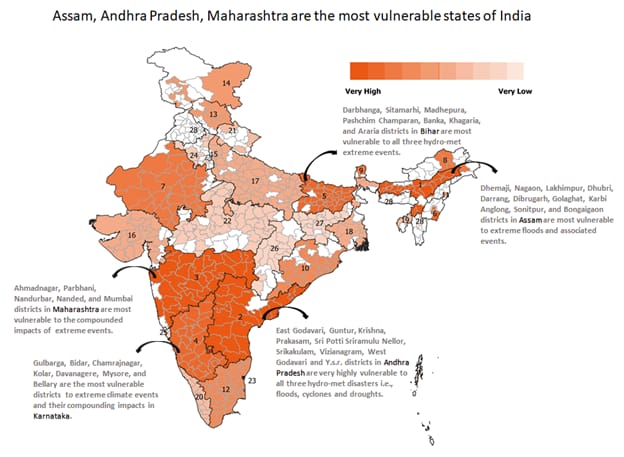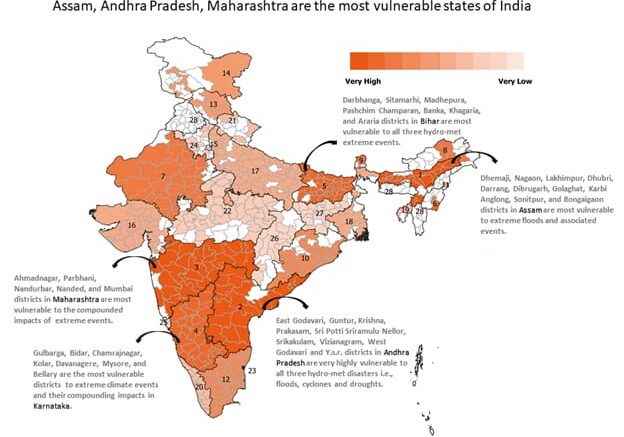– More than 80 per cent Indians live in climate vulnerable districts
– Access to climate finance will be critical for strengthening adaptation efforts and covering loss and damage
Mumbai, 26 October 2021 (GPN): The states of Assam, Andhra Pradesh, Maharashtra, Karnataka and Bihar are most vulnerable to extreme climate events such as floods, droughts and cyclones in India, according to a first-of-its-kind Climate Vulnerability Index released today by the Council on Energy, Environment and Water (CEEW). Overall, 27 Indian states and union territories are vulnerable to extreme climate events which often disrupt the local economy and displace weaker communities. More than 80 per cent Indians live in districts vulnerable to climate risks.
At the upcoming climate talks, known as COP-26, in Glasgow, developing countries like India are expected to demand that developed countries ramp up and deliver climate finance timely. This will help developing countries to strengthen adaptation mechanisms against such extreme climate events and also accelerate the low-carbon transition. The existing commitments made by developed countries are insufficient and yet to be met.
The study, supported by the India Climate Collaborative and Edelgive Foundation, further highlighted that 463 out of 640 districts in India are vulnerable to extreme floods, droughts and cyclones. More than 45 per cent of these districts have undergone unsustainable landscape and infrastructure changes. Further, 183 hotspot districts are highly vulnerable to more than one extreme climate event. The CEEW study also found that more than 60% of Indian districts have medium to low adaptive capacity.
Dhemaji and Nagaon in Assam, Khammam in Telangana, Gajapati in Odisha, Vizianagaram in Andhra Pradesh, Sangli in Maharashtra, and Chennai in Tamil Nadu are among India’s most climate vulnerable districts.
Dr Arunabha Ghosh, CEO, CEEW, said, “Combating the rising frequency and scale of extreme climate events is fiscally draining for developing countries such as India. At COP-26, developed countries must regain trust by delivering the USD 100 billion promised in 2009 and commit to stepping up climate finance over the coming decade. Further, India must collaborate with other countries to create a Global Resilience Reserve Fund, which could act as insurance against climate shocks. This would ease the fiscal pressure on the most climate vulnerable countries, especially from the Global South. Finally, developing a Climate Risk Atlas for India would help policymakers to better identify and assess risks arising from extreme climate events.”
 Abinash Mohanty, Programme Lead, CEEW, and lead author of the study, said, “The frequency and intensity of extreme climate events in India have increased by almost 200 per cent since 2005. Our policymakers, industry leaders and citizens must use the district-level analysis to make effective risk-informed decisions. Climate-proofing of physical and ecosystem infrastructures should also now become a national imperative. Further, India must create a new Climate Risk Commission to coordinate the environmental de-risking mission. Finally, with loss and damage rising exponentially due to the climate crisis, India must demand climate finance for adaptation-based climate actions at COP-26. Enhanced climate finance can also support India-led global agencies like the Coalition for Disaster Resilient Infrastructure (CDRI) to further mainstream climate actions.”
Abinash Mohanty, Programme Lead, CEEW, and lead author of the study, said, “The frequency and intensity of extreme climate events in India have increased by almost 200 per cent since 2005. Our policymakers, industry leaders and citizens must use the district-level analysis to make effective risk-informed decisions. Climate-proofing of physical and ecosystem infrastructures should also now become a national imperative. Further, India must create a new Climate Risk Commission to coordinate the environmental de-risking mission. Finally, with loss and damage rising exponentially due to the climate crisis, India must demand climate finance for adaptation-based climate actions at COP-26. Enhanced climate finance can also support India-led global agencies like the Coalition for Disaster Resilient Infrastructure (CDRI) to further mainstream climate actions.”
The CEEW study also highlighted that states in India’s northeast are more vulnerable to floods, while the ones in the south and central are most vulnerable to extreme droughts. Further, 59 and 41 per cent of the total districts in the eastern and western states, respectively, are highly vulnerable to extreme cyclones.
The CEEW study also indicated that only 63 per cent of Indian districts have a District Disaster Management Plan (DDMP). While these plans need to be updated every year, only 32 per cent of them had updated plans until 2019. Highly vulnerable, states like Maharashtra, Tamil Nadu, Odisha, Karnataka and Gujarat have improved their respective DDMPs and climate-proofed critical infrastructures in the recent years.
The CEEW study recommended that restoration of climate-sensitive landscapes will act as natural shock absorbers against extreme climate events. Further, integration of climate risk profiling with infrastructure planning is imperative for protecting the existing and planned infrastructure projects. The findings are relevant since India is considered the seventh most vulnerable country across the globe, according to the Climate Risk Index by Germanwatch.
The CEEW study is the first one to assess the vulnerability of India’s districts against extreme climate events.
The study ‘Mapping India’s Climate Vulnerability’ can be accessed here.
Contact: Riddhima Sethi (CEEW) – [email protected]; +91 99020 39054 / [email protected]
Methodology
Further to the comprehensive hazard assessment launched by CEEW in December 2020, this study maps the exposure of Indian districts to extreme hydro-met and associated events in terms of their frequency and intensity. This data is integrated with spatial mapping of the sensitivity of landscape indicators (land-use-land-cover, soil moisture, groundwater, slope, and elevation) to extreme climate events. The study also assesses adaptive capacity by considering a wide set of socio-economic indicators such as population density, Gross District Domestic Product (GDDP), literacy ratio, sex ratio, availability and accessibility of critical infrastructures, availability and accessibility of shelters, and robustness of district disaster management plans (DDMPs).
About CEEW
The Council on Energy, Environment and Water (CEEW) is one of Asia’s leading not-for-profit policy research institutions. The Council uses data, integrated analysis, and strategic outreach to explain – and change – the use, reuse, and misuse of resources. It prides itself on the independence of its high-quality research, develops partnerships with public and private institutions, and engages with wider public. In 2021, CEEW once again featured extensively across ten categories in the 2020 Global Go To Think Tank Index Report. The Council has also been consistently ranked among the world’s top climate change think tanks. Follow us on Twitter @CEEWIndia for the latest updates.


Be the first to comment on "Assam, Andhra Pradesh, Maharashtra most vulnerable to extreme climate events: CEEW"